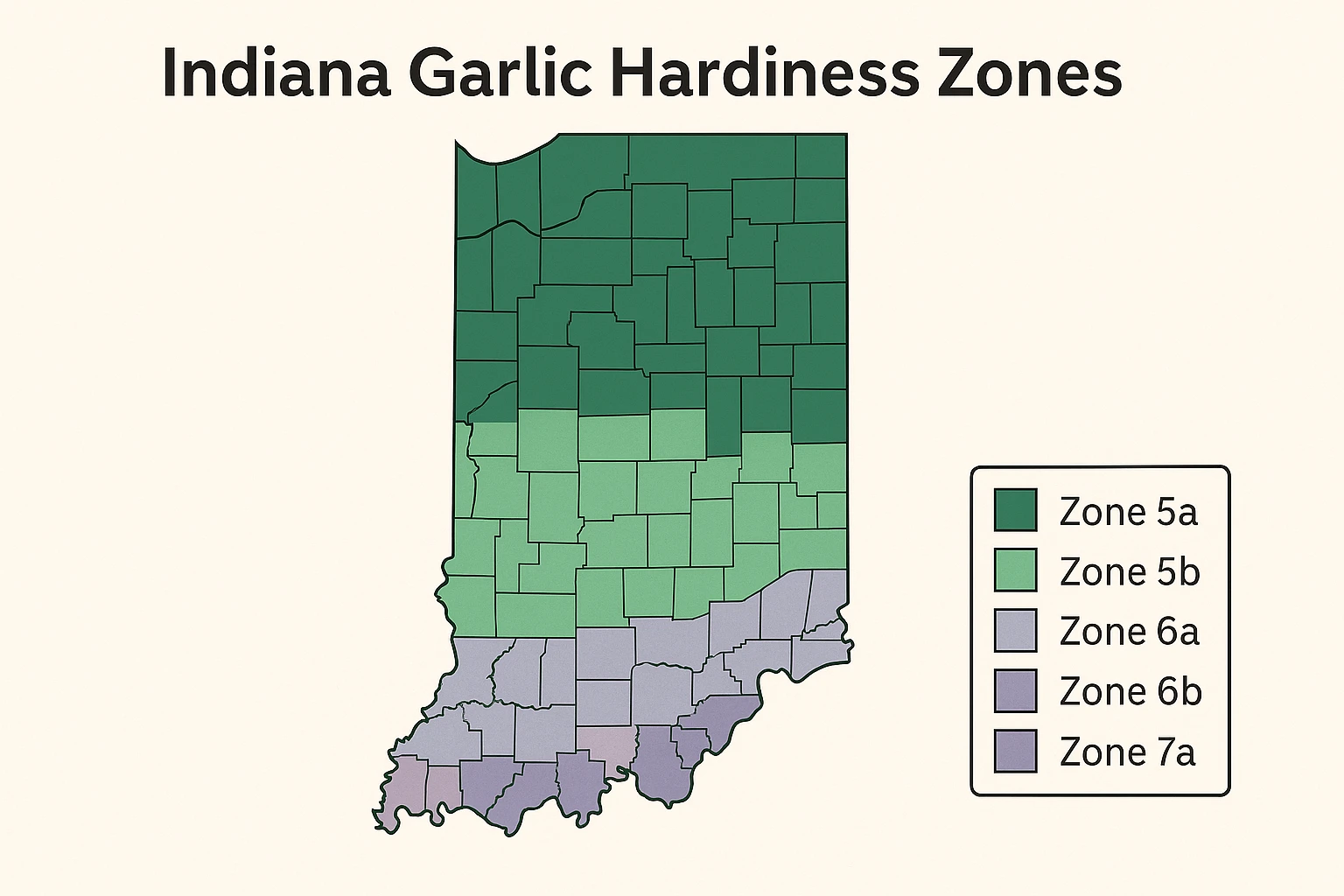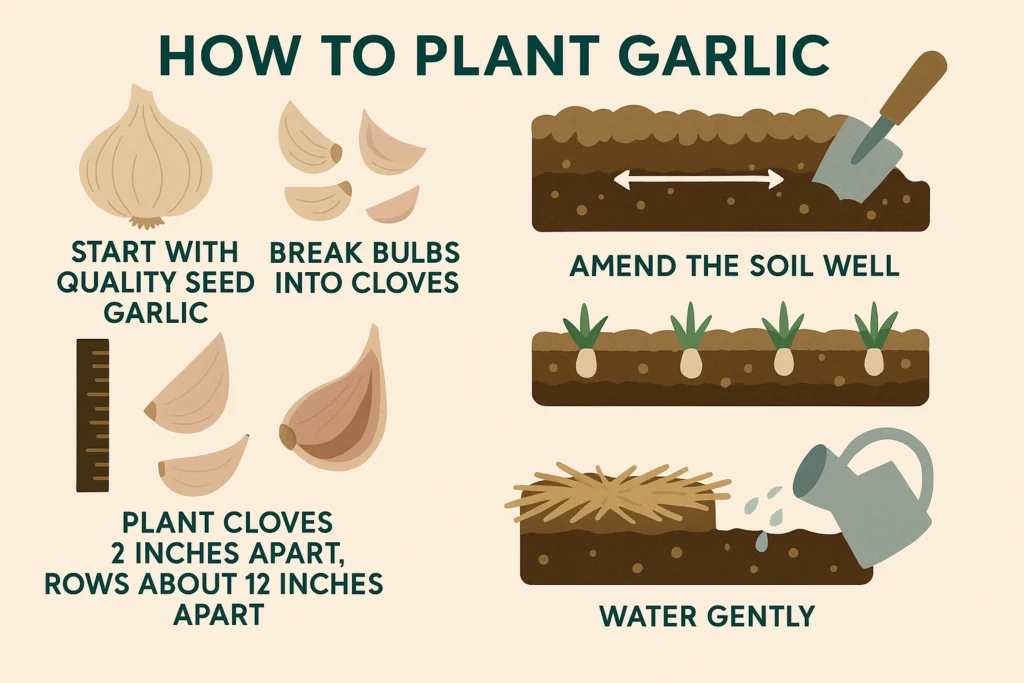When to Plant Garlic in Indiana (What I’ve Learned from Gardening Across Growing Zones)

The best time to plant garlic in Indiana is between mid-October and early November, depending on your location within the state. Northern Indiana gardeners should aim for October 10–20, while those in central or southern Indiana can plant through late October into early November. Garlic should be planted when soil temperatures drop below 50°F but before the ground freezes to allow proper root development before winter.
Over the years, I’ve had the chance to grow garlic in different parts of the country, and while the basics hold steady—cool soil, good drainage, a bit of patience—planting garlic in Indiana brings its own timing and temperament.
Indiana sits in that in-between spot: not quite the deep freeze of Minnesota, but colder and more variable than much of the South. For garlic, that means timing is everything, and the window is narrower than you might expect.
Here’s what I’ve picked up from growing garlic in similar climates—and what Indiana gardeners might want to keep in mind.
Table of Contents
When to Plant Garlic in Indiana?
Let’s start with the short answer.
The best time to plant garlic in Indiana is from mid-October through early November.
In northern Indiana, I’d lean toward October 10–20. In the central and southern parts of the state, you can safely plant through late October into the first week of November.
That said, if there’s one thing I’ve learned, it’s that garlic responds to soil temperature more than dates on the calendar. You want to plant when the soil has cooled to around 50°F, but before it freezes. That balance—cool, but not frozen—is where garlic thrives.
One season, I got overconfident and planted early—first week of October. We had a long warm spell, and the cloves sprouted before Halloween. By January, most of the greens were burned off. The bulbs still formed, but they were uneven, and a few had split wrappers from frost damage. Since then, I wait.ter the first light frost to get started. It’s not scientific, but he says that’s been his best teacher.
Why Timing Garlic in Indiana Requires a Little Patience?
Indiana’s fall weather can lull you into planting too soon. A few cool nights in late September, and it feels like the season’s turned. But garlic doesn’t need weeks of leaf growth—it needs 2 to 3 solid weeks to grow roots before the ground goes hard.
Plant too early, and warm soil can encourage sprouting. Plant too late, and the cloves won’t anchor before winter.
If I were gardening full-time in Indiana, I’d watch for a consistent drop in overnight temps into the 40s and aim to get the cloves in the ground about three weeks before your area’s first hard freeze. In most of Indiana, that means around mid to late October.
How I Plant Garlic (And How I’d Do It in Indiana)?
The method doesn’t change much by state, but I do make adjustments based on weather and soil.
Here’s my standard approach, adapted for Indiana garlic planting:
- Choose your garlic wisely. Hardneck varieties tend to do best in Indiana’s winter conditions. I’d go with tried-and-true types like ‘Music’, ‘German White’, or ‘Chesnok Red’.
- Break bulbs into cloves just before planting. Don’t remove the skins.
- Plant cloves 2-3 inches deep, with the pointed end up. In heavier Indiana soils, I stay closer to 3 inches to avoid frost heaving.
- Space cloves 6 inches apart, with rows about 12 inches apart.
- Amend the soil. Indiana soils vary, but many regions deal with clay. Compost and sand can improve drainage.
- Mulch heavily—4 to 6 inches of straw or shredded leaves. I’ve skipped this step in the past and regretted it. Freeze-thaw cycles in the Midwest can lift cloves right out of the ground.
- Water lightly, just enough to settle the soil.
If you’re working in raised beds or newly built garden boxes (which I often recommend in clay-heavy areas), use a Soil Volume Calculator to get your fill amount right.
A Note on Garlic Varieties for Indiana
As mentioned, hardneck garlic is generally the way to go in Indiana. These varieties handle cold winters well and often produce bigger, more flavorful cloves.
Some southern Indiana growers do experiment with softneck garlic, and in mild winters, it can work. But I’d still lean toward hardneck for reliability, especially in zones 5 and 6, which cover most of the state.
One tip: don’t chase rare varieties before you’ve mastered one or two staples. Stick to reliable seed garlic for the first couple of seasons—you’ll thank yourself later.
Mistakes I’ve Made (That You Can Avoid in Indiana)
No matter where I’ve grown garlic, a few universal mistakes tend to creep in. Indiana gardeners aren’t immune, and if anything, the Midwest’s mix of warm fall days and sudden cold snaps makes timing even more important.
Here’s what I’ve learned the hard way:
- Don’t plant too shallow. Garlic heaves easily in fluctuating winter soil. At least 2 inches deep—3 if the soil is loose.
- Don’t skimp on mulch. In Indiana, mulch does more than protect from cold—it moderates the swing between freeze and thaw.
- Don’t use grocery store garlic. It’s tempting, but most of it isn’t bred for Indiana winters. Buy seed garlic.
- Watch your soil pH. Garlic prefers slightly acidic soil, around 6.0–6.5. I’ve seen bulbs underperform in too-alkaline soil. If you’re not sure, check with this Soil pH Calculator.
Can You Plant Garlic in Spring in Indiana?
Technically, yes. But it’s a backup plan, not a strategy.
Garlic planted in spring doesn’t have the same time to develop roots before the heat sets in. I’ve done spring planting when fall slipped past me, and the result was always the same: smaller bulbs, less impressive flavor, and limited storage life.
If spring is your only option, use softneck garlic, plant as early as you can work the soil, and accept that the yield won’t match a good fall crop.
Before you plant garlic, it’s essential to know your USDA Planting Zone. Garlic planting times vary based on local climate and frost patterns. Whether you’re in Zone 5b or Zone 9a, adjusting your planting schedule to your zone ensures a successful harvest. You can easily find your zone with this USDA Planting Zone Lookup and plan accordingly.
When to Harvest Garlic in Indiana?
Most Indiana gardeners find themselves harvesting garlic between late June and early July, depending on the variety and when it was planted.
The signal to watch for is when the lower third to half of the leaves have turned brown, but the upper leaves are still green. Pulling too early stunts development. Waiting too long makes the wrappers soft and prone to mold.
Stop watering 2-3 weeks before harvest. It dries the soil, tightens the wrappers, and makes for cleaner curing.
Final Thoughts: Garlic Grows Well in Indiana, If You Get the Timing Right
When to plant garlic in Indiana isn’t about following a fixed calendar date—it’s about reading the soil, watching the weather, and trusting experience.
For most of the state, mid to late October is your sweet spot. Go too early, and warm soil might trigger early growth. Wait too long, and you miss the rooting window. Somewhere in between is where the magic happens.
If you’re looking for a broader overview of planting garlic anywhere, this Garlic Planting Guide is a great starting point. But if you’re growing in Indiana, local attention makes all the difference.
FAQs: When to Plant Garlic in Indiana
What is the best month to plant garlic?
In most places, including Indiana, October is the best month to plant garlic. The goal is to get the cloves into cool—but not frozen—soil. That usually means planting mid to late October, depending on how quickly fall sets in where you live.
What is the best garlic to plant in Indiana?
For Indiana’s winter climate, hardneck garlic is generally the best option. Varieties like ‘Music’, ‘Chesnok Red’, and ‘German White’ do particularly well. They can handle the cold and produce large, flavorful cloves. Softneck garlic can work in southern Indiana, but it’s less reliable overall.
In which season is garlic grown in India?
In India, garlic is typically a rabi (winter) crop. It’s usually planted from October to November and harvested in late spring. The timing aligns with cooler weather, similar to fall planting in the U.S., though the climate is obviously different depending on region.
Which month is best for garlic?
The best month for garlic planting is usually October, especially if you’re planting in regions like the Midwest or northern states. In warmer zones like the southern U.S., you might plant later—into November or early December.
Can we grow garlic in summer?
Garlic doesn’t do well when planted in summer. It needs cool soil to establish roots, followed by winter chill (especially for hardneck types). Summer planting usually leads to poor root development, small bulbs, or failed crops. However, you can harvest garlic in summer—typically June or July, depending on when it was planted.
Which fertilizer is best for garlic?
Garlic likes a balanced, slow-release fertilizer rich in nitrogen during its early growth phase. I’ve had good luck with blood meal, fish emulsion, or a balanced 10-10-10 organic fertilizer. Just go easy—too much nitrogen later in the season can reduce bulb size. Use our npk fertilizer calculator to get more details.

